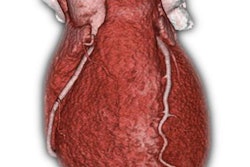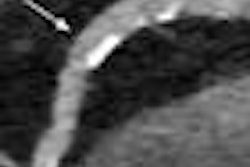
A multiyear Dutch study has found that coronary CT angiography (CCTA) delivers similar diagnostic accuracy in men and women. Numerous factors separating the sexes in evaluation of coronary artery disease -- from symptomology to test results -- have conspired against this conclusion, but the trial of nearly 600 symptomatic patients found sensitivity of 97% in low-risk women versus 100% in men, and specificity of 79% in women versus 90% in men, with similar results in intermediate-risk patients.
The high mortality rates due to heart disease among women has, in part, been related to a lack of recognition that heart disease is the number one killer in women as well as men, wrote the authors from Erasmus Medical Center in Rotterdam (European Radiology, 6 June 2012, online first).
"The interpretation of chest pain in women caused by CAD (coronary artery disease) is often difficult because of the 'less typical' symptoms in women compared with the classical 'typical' symptoms in men," explained Dr. Anoeshka Dharampal, Dr. Stella Papadopoulou, Dr. Alexia Rossi and colleagues. "This may cause a delay or lead to incorrect diagnosis. Additionally first-line noninvasive diagnostic tests, such as exercise electrocardiography and single photon emission computed tomography (SPECT) imaging in women, are less sensitive and specific."
Paradoxically, the resulting uncertainty has led to more-frequent use of invasive coronary angiography among women, where CCTA has potential to be a safer and less-invasive gatekeeper exam as it is in men, they said. But "whether this also applies to women remains unresolved because women have been under-represented in studies assessing the diagnostic accuracy of CCTA," they wrote.
The study aimed to evaluate the diagnostic accuracy and clinical utility of CCTA to detect or exclude obstructive CAD in women with a low-to-intermediate pretest probability of obstructive CAD in comparison to men.
The retrospective study included 570 symptomatic patients stratified as low-risk (46% women [262/570]) to intermediate risk (women 39% [182/461]) who underwent both invasive coronary angiography and CCTA. Patients who had undergone previous revascularization or sufferered a myocardial infarction were excluded.
The pretest probability of CAD was estimated using the Duke risk score. Low risk indicated a risk of 30% or less, while 30%-90% was used for determining intermediate risk. The diagnostic accuracy of CCTA in detecting obstructive CAD (≥50% lumen diameter narrowing) was calculated on patient level, with p < 0.05 considered significant, Dharampal and colleagues noted.
For the first two years of the study (2004-2006) patients underwent single-source CTA (Somatom Sensation, Siemens Healthcare). Thereafter patients were scanned at dual-source CT (Somatom Definition, Siemens Healthcare), following administration of iodinated contrast, metropolol heart-rate lowering medication, and sublingual nitroglycerin. Imaging began with unenhanced CT.
After the introduction of ECG-triggered tube current modulation, the spiral imaging technique with ECG-pulsing was used in the subsequent exams to reduce the effective radiation dose. Data sets were reconstructed retrospectively according to the heart rate to obtain motion-free images.
Spiral imaging with ECG-triggered tube current modulation was used after its introduction to reduce the radiation dose. Data sets were reconstructed retrospectively based on heart rate at 31%-47 % of the R-R interval (systolic phases) for heart rates 80 bpm and higher, 60-76 % of the R-R interval (diastolic phases) for heart rates 65 bpm or less. For heart rates between 66 and 79 bpm, reconstructions were created in both the systolic and diastolic phases.
All data sets were transferred for analyses to an offline proprietary workstation (Leonardo, Siemens Healthcare) for review by two experienced readers who were blinded to the results of invasive coronary angiography. The 17-segment American Heart Association model was used to classify each segment, which was deemed obstructive in the presence of at least 50% narrowing in two orthogonal planes.
Sensitivity, specificity, positive predictive value (PPV), and negative predictive value (NPV) were not significantly different in and between women and men at low and intermediate risk, the authors reported.
In addition, the prevalence of obstructive CAD and extent of CAD in terms of multivessel disease and calcium score were similar between women and men. The interobserver variability for detection of obstructive stenosis showed a good agreement on segment (ĸ = 0.94 [95% CI 0.93-0.95]) and patient levels (ĸ = 0.91 [95% CI 0.87-0.95]). Finally, the diagnostic image quality was not significantly different between women and men (0.96 vs. 0.97, p = 0.06).
Certainty defined as probabilities for obstructive CAD of 5% or less after a negative CCTA exam were achieved in both women (NPV 97% and 98% for low and intermediate risk, respectively) and men (NPV 100% and 99% for low and intermediate risk, respectively). In addition, the low yield of obstructive coronary artery disease after a negative CCTA exam would prevent 31% of the low-to-intermediate-risk patients proceeding to invasive angiography.
"CCTA has similar diagnostic accuracy in women and men at low and intermediate risk," they wrote.
The demographics between men and women were similar except that women overall had a higher heart rate (HR) than men (P = 0.03). Heart rates were similar in the different risk groups, however. The prevalence of coronary artery disease was 61% in women and 64% (p = 0.002) in men. The pretest probably was lower than the observed prevalence of obstructive coronary artery disease by invasive coronary angiography in women in the overall group as well as the low-risk group, while in men there was no difference between the estimated pretest probability (65% overall) and observed prevalence (64%). Finally, the prevalence of obstructive coronary artery disease and multivessel disease were similar between men and women.
No significant differences were found between the single-source and dual-source CT systems used in the study for sensitivity, specificity, positive predictive value, or negative predictive value.
Diagnostic accuracy of CCTA versus invasive coronary angiography in 570 patients
|
The clinical evaluation of CCTA versus invasive coronary angiography in low-to-intermediate-risk women and men with suspected coronary artery disease found that:
The Duke risk score underestimated the prevalence of angiographically obstructive CAD in women, especially in the low-risk group. The overall predicted probability of having obstructive CAD using the Duke risk score was underestimated in women (45% vs. 61%, P<0.01) compared with the actual presence of CAD assessed by invasive coronary angiography. This finding probably reflects the difficulties of evaluating women with symptoms suspected of CAD and has been described in previous studies.
The sensitivity and specificity of CCTA were similar across low- and intermediate-risk groups in and between both genders (sensitivity 99% in women versus 99% in men; specificity 77% in women versus 85% in men), Dharampal et al wrote.
The clinical utility of a positive CCTA was moderate, with remaining diagnostic uncertainty in low- to intermediate-risk women and low-risk men requiring additional functional testing. In the study population the clinical utility of a positive CCTA was high (>90 %) in men at intermediate pretest probability of coronary artery disease, and therefore further diagnostic testing was not necessary before referral to angiography, they wrote. But the clinical utility of a positive CCTA exam was only moderate in women at low to intermediate pretest probability and further diagnostic testing, i.e. functional testing for ischemia using SPECT or stress echocardiography, was needed.
The yield of obstructive coronary artery disease at coronary angiography was similar in women (27%-49 %) and men (47%-67%), with low or intermediate risk. But performing CCTA before angiography improved the yield to 86% in women and 92% in men.
CCTA was highly accurate in excluding the presence of obstructive CAD in women and men at low and intermediate risk, providing high certainty (<5 %) of absence of obstructive CAD, and no further testing would be necessary.
Several studies have shown that "the absence of CAD detected by CCTA is associated with an excellent prognosis which further lends support that these patients may be safely discharged," Dharampal et al wrote. "In patients with persistent chest complaints due to microvascular dysfunction, normal CT findings with no obstructive epicardial [coronary artery disease] may be seen. In these patients, who are often women, further diagnostic testing for ischemia to detect microvascular dysfunction will be needed to adjust clinical management and survival."
The study's limitations include referral bias, since the patients were referred for angiography following their presentation with chest pain, with or without stress testing. To account for the influence of referral bias on the diagnostic accuracy of CCTA, the group also reported the area under the curve, which was not significantly different between women and men (0.87 versus 0.92, p=0.056).
CCTA's similar diagnostic utility between men and women permit it to be used as an efficient gatekeeper to invasive coronary angiography, Dharampal and colleagues concluded.



















